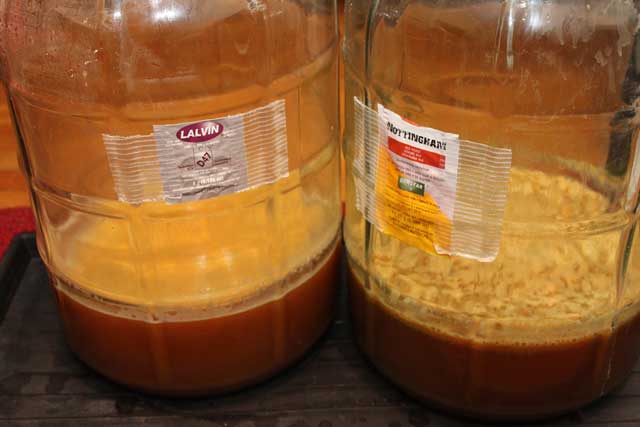 It’s still summer-time, yet I was getting a hankering for some hard cider. I don’t know why. It seems incredibly popular these days, but I’ve been brewing it for 7 years now, so I don’t see what the big deal is. That said, a curiosity struck me recently regarding cider. Traditionally, I’ve always aimed for a low-alcohol, semi-dry / semi-sweet hard cider. Something that won’t offend and play to many palettes. This means using cider with an original gravity of 1.050 and then stopping it early at around 1.010 or 1.012 — the perfect semi-dry/semi-sweet spot.
It’s still summer-time, yet I was getting a hankering for some hard cider. I don’t know why. It seems incredibly popular these days, but I’ve been brewing it for 7 years now, so I don’t see what the big deal is. That said, a curiosity struck me recently regarding cider. Traditionally, I’ve always aimed for a low-alcohol, semi-dry / semi-sweet hard cider. Something that won’t offend and play to many palettes. This means using cider with an original gravity of 1.050 and then stopping it early at around 1.010 or 1.012 — the perfect semi-dry/semi-sweet spot.
The curiosity these days for me is about a few things.
- A tasty, yet dry cider. (FG of 1.000 and 1.005)
- A high-alcohol cider. (6% ABV or higher)
- What yeast to get there?
And thus an experiment was born…
- Acquire 2.5 gallons of Trader Joe’s apple cider and put 1 gallon in each carboy.
- Heat the remaining 1/2 gallon to 130F (55C) and dissolve 1 lb of brown sugar into the cider.
- Divide equally between the two carboys and take a gravity reading from each. (OG was 1.067 for both)
- Pitch Danstar Nottingham Ale yeast into one carboy and Lalvin D47 Wine yeast into the other.
Observations so far:
- Incredibly fast start on the Nottingham Ale yeast. The Lalvin D47 was also started within a few hours, but the Nottingham was going in under an hour. Temperature for both was around around 85F, so I’m sure that helped..
- These yeasts both operate ideally under 70F, so they will be moved to a cooler area of the house.
Hypothesis / expectations:
- Original Gravity of 1.067 and Final Gravity of 1.003 (guesstimate) will make this an 8.5% ABV cider.
- Both will complete in under a week since it is so warm. The Nottingham will finish first, likely. Partly due to having twice the starting volume of dry yeast. (5g vs 11g)
- Both will finish dry (< 1.005), though I’m guessing that the Nottingham will leave more apple flavor while the D47 wine yeast will leave only a delicate apple flavor behind.
UPDATE Aug 30, 2014:
It’s been 5 days and the two ciders have been kept around 72F (+/- 2F) — At this point, I figured that they should be close to being done, but wasn’t sure, so a gravity reading was taken using a wine thief. Surprisingly, the Lalvin D47 wine yeast was further along despite having the slower start. It was at 1.010. The Danstar Nottingham was at 1.024 — I found this surprising, but perhaps I shouldn’t be.
The wine yeast has evolved to eat fruit sugar (like grapes and apples) as opposed to grain sugar (like barley and wheat). In addition to this, the wine yeast has also been selected for its ability to go to a higher alcohol level like 14%, so maybe it isn’t so surprising that the wine yeast is further along than the ale yeast.
Please, read on for the results of the hard cider yeast experiment.



1 pings
Results from the hard cider yeast experiment » Ranger Pretzel
September 17, 2014 at 7:02 PM (UTC -4) Link to this comment
[…] « A hard cider yeast experiment […]